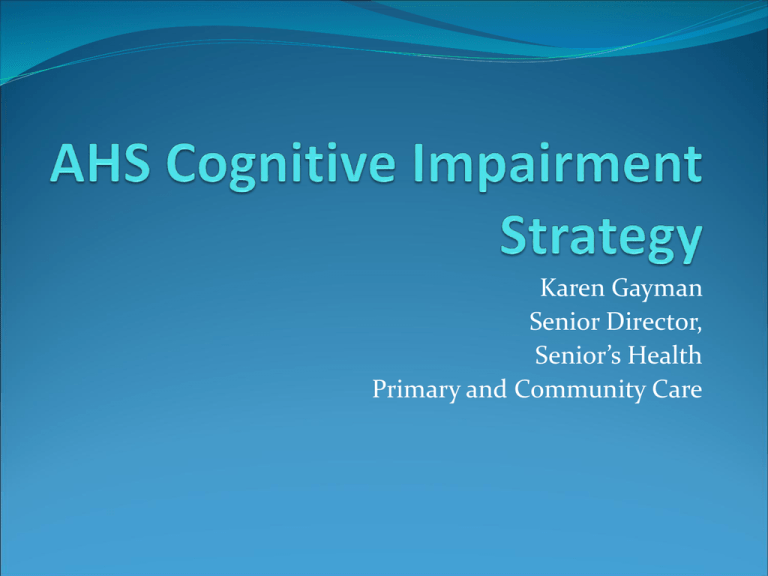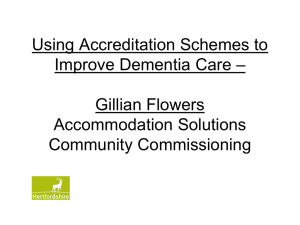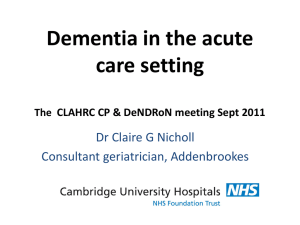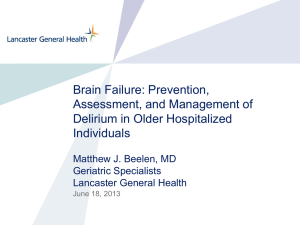Living Well With Dementia
advertisement

Karen Gayman Senior Director, Senior’s Health Primary and Community Care Background In 2002 AHW, in collaboration with stakeholder from the Regional Health Authorities, developed a paper entitled, ALZHEIMER DISEASE & OTHER DEMENTIAS: Strategic Directions in Healthy Aging and Continuing Care in Alberta. Health Authorities were charged with developing regional implementation plans to address the strategic direction outlined in this document. Regions had varying capacity to accomplish the work. In April of 2009, the former health regions joined to become the provincial operating unit of Alberta Health Services (AHS). The Seniors Health Provincial team was created in this reorganization. Cognitive Impairment Team Deliverables: Develop and implement a provincial dementia/delirium strategy across Alberta to improve the quality of care and enhance the provision of services provided to Alberta’s continuing care clients assessed and diagnosed with dementia or delirium. The strategy will help to promote a shift in the approaches utilized by AHS to support the unique needs of cognitively impaired continuing care clients from a chronic disease perspective, and will also help to support and standardize programs that provide opportunities for socialization, engagement in meaningful activities, and exercise. Our vision: Persons with Dementia and their Carers are supported throughout their journey Health Service Planning Policy and practice Service Framework Workforce: Staff competence Education AHS - Seniors Health 2012 Cognitive Impairment Strategy Prevention & Wellness Early Recognition Living With End of Life Congregate SupportiveLiving Care, Symptom management, Bereavement Support Create and Implement Dementia Sensitive Policy and Services Guidelines Across the continuum Public health Public Awareness & prevention Home Primary Care Acute Care living Diagnosis, Community services, education, System Crisis response, navigation, Advance Delirium Protocols care planning Implement best practice guidelines for Dementia care and Delirium prevention/management Ensure Healthcare staff have the knowledge and skills to provide quality dementia care in settings where this competence is supported and valued Family caregiver support: respite, Offer appropriate support and education to Carers at each stage, provide quality respite services education Community Partner with community services to enhance quality of life for those with dementia partners Research and Support Cognitive impairment research agenda: partner with academic institutions Innovation Information Plan, Provide and monitor care based on valid outcome indicators (KPIs) management Our mission is to provide person centered care that is accessible and sustainable for all Albertans Strategy Pillars Health Service planning for those with Cognitive Impairments (Dementia) is grouped into four phases of the disease journey: Prevention and Wellness; Early signs, obtaining a diagnosis and making plans for the future; Living well with Dementia; and Support at End of Life. Strategy Pillar 1 Prevention and Wellness. Public information is needed to educate about dementia and healthy living strategies such as exercise and maintain social supports. Working with community partners such as the Alzheimer Society is a key strategy in meeting this goal. Key public message: “stay active and healthy; stay socially connected” Strategy Pillar 2 Early Signs, Obtaining A Diagnosis And Making Plans For The Future. Core health services include: obtaining a cognitive assessment and a medical diagnosis of the underlying cause of a cognitive impairment within a timely manner from the beginning signs of cognitive decline. Supporting the person with cognitive impairments, and their family caregivers, to participate in planning for their future, early in the journey is important and occurs over time. Partnerships with the Alzheimer’s Society “First Link” program are key strategies to addressing these support needs. Key public message: “significant memory loss is not normal aging; take steps to plan ahead” Strategy Pillar 3 Living Well With Dementia. Services in the community such as Dementia specific Adult Day Support Programs are key to “living well.” Support programs for those adjusting to the diagnosis and for those providing the majority of the care at home are also key services. Dementia specific respite services, provided by staff (HCAs) who are knowledgeable and skilled at Personcentered Dementia care are fundamental services required to support family caregivers Strategy Pillar 3 con`t As needs increase, Supportive Living and Long Term Care services may be required. Staff who have the education and organizational support to provide evidence based dementia care in settings that are designed for this population are key. The goal is to provide Care that aims to prevent responsive behaviours, such as frustration that may result in ‘aggression’ and promote quality of living “in the moment”. Individualized care planning is necessary to address Behavioural and Psychological Symptoms of Dementia (BPSD). Minimizing the need for restraints (physical, environmental and with chemicals restraints such as anti-psychotic medications) is the goal of supporting the person to live well with the dementia in a congregate living environment. Strategy Pillar 4 Support at End of Life. Care at the end of life is supportive and avoids invasive quality. Family caregivers are supported throughout the journey to appreciate the debilitating progression of the disease that results in death. Our vision: Persons with Dementia and their Carers are supported throughout their journey Health Service Planning Policy and practice Service Framework Workforce: Staff competence Education AHS - Seniors Health 2012 Cognitive Impairment Strategy Prevention & Wellness Early Recognition Living With End of Life Congregate SupportiveLiving Care, Symptom management, Bereavement Support Create and Implement Dementia Sensitive Policy and Services Guidelines Across the continuum Public health Public Awareness & prevention Home Primary Care Acute Care living Diagnosis, Community services, education, System Crisis response, navigation, Advance Delirium Protocols care planning Implement best practice guidelines for Dementia care and Delirium prevention/management Ensure Healthcare staff have the knowledge and skills to provide quality dementia care in settings where this competence is supported and valued Family caregiver support: respite, Offer appropriate support and education to Carers at each stage, provide quality respite services education Community Partner with community services to enhance quality of life for those with dementia partners Research and Support Cognitive impairment research agenda: partner with academic institutions Innovation Information Plan, Provide and monitor care based on valid outcome indicators (KPIs) management Our mission is to provide person centered care that is accessible and sustainable for all Albertans Strategy “Swim lanes” , the Service Framework Health Service Delivery: define the overall service goal(s); determine the services required to meet this goal and the care guidelines to be implemented in the provision of this care. Set the standards to be met in the care delivery. Describe the components of the best physical environment for the services to be offered. The Workforce: detail the workforce (type and numbers) required to provide the health services described above. Describe the required competence for these groups of staff, including recommendations about educational programs and innovative Knowledge Management approaches (e.g. establishment of communities of practice and introduction of zone based Dementia Knowledge Brokers). Performance Appraisal tools to support workforce development toward meeting the expected competence will be recommended. Family caregivers: The service needs of the family caregivers will be addressed for each phase of the disease: considering knowledge (education), support and respite needs. As well, each group will consider the service needs of recognized sub-groups within the dementia population: younger adults who develop dementia; individuals and their family caregivers who do not communicate in English, those with an aboriginal heritage, individuals who live alone. Partners: The strategy will be enhanced by working with community partners such as the Alzheimer’s Society. Engaging municipalities in related issues such as modifying recreation programs to meet the needs of those with early stage dementia will help create the community response needed to help people live well in the community. Research and Innovation: Partnering with academic institutions and being an active participants in setting research agendas to address the “unknowns” in the strategy is a key step in building an evidence based system of health care related to dementia. Information Management: Determine the system level key performance indicators (KPI) that will demonstrate the success in meeting the expectations described. Strategy Implementation focus: AH grant funding for implementation of CI strategy was primarily focused on the “Living with Dementia” components of the CI strategy Building Workforce Capacity through staff competency training programs Best Practice Development in Delirium Management Research and Innovation Community Partnerships Service Delivery model development Supportive Livingdementia (SL4-D) Focus of Strategy Work 11/12 Building Work Force Competency through training programs: Nursing Improving the Care of Health System Elderly (NICHE) project Evergreening Supportive Pathways project PIECES review Decision Making Capacity project NICHE 2 day curriculum designed for Nurses (RN/LPN), Allied Health professionals, developed by nurse scholars at NYU Curriculum has an acute care focus on delirium prevention, however, continuing care staff reviews suggest applicable in community practice Content focused on optimizing geriatric care: sleep and rest, elimination, hydration and nutrition, independence and mobility, orientation(dementia, delirium, depression assessments), pain, sensory changes, communication, atypical presentation, medication management, and environment. NICHE project NICHE education focused on delirium prevention strategies: over 2300 staff attended NICHE education. NICHE Zone leads were established to provide workshops in each zone In addition to the full NICHE course, 4 shorter in services to staff on the Delirium protocol were offered by Zone NICHE educators at MHRH and RDRH between January and March 2012. Evaluation: positive results Supportive Pathways A 2 day team based (RN, LPN, HCA, Allied Health and leaders) continuous learning program designed to create a philosophy and approach to person centred care for those with dementia living in a continuing care stream ( SL, LTC) Program content covers: values and beliefs (staff, clients, family theory, organizational), normal aging changes, types of dementia, disease progression and impact on a person’s abilities, effective communication strategies in caring for a dementia client, meaningful activities for normalized living, environmental modifications to support abilities,, reduce challenging behaviour responses, inviting family care activities, avoiding need for restraints and caring for those who have tendency towards responsive behaviours (agression) Evergreening Supportive Pathway project Clinical experts and educators developed working group to review program of education Revisions and updates to content completed Supportive Pathways educators provided with updates and changes to Supportive Pathway curriculum Supportive Pathways was previously recognized as the dementia training program in the AHW 2005 HCA curriculum. HCA curriculum was revised and supportive pathway education was replaced with new modules for the HCA dementia education P.I.E.C.E.S Physical, intellectual, emotional, capabilities, environment and social P.I.E.C.E.S is a 2 day educational program for professional staff withon one day follow up session 6-8 weeks post first session Is a best practice learning and development initiative that provides an approach to understanding and enhancing care for individuals with complex physical and cognitive/mental health needs and behavioural changes Provides a systematic approach to common issues, diagnosis and challenges of older persons at risk including those with aggressive behaviour Promotes team dialogue and shared problem solving techniques P.I.E.C.E.S Copywrite to offer the program to Alberta Community Care settings is held by Bethany Rosehaven in Camrose. Staff attrition at Rosehaven has impacted the organization’s ability to offer courses A comparative review of PIECES education relative to NICHE and Supportive Pathway to be conducted Based on review and consultation with stakeholders recommendations and a way forward plan to be developed Decision Making Capacity Project In 2009, a working group of the CI Advisory committee began working on a provincial process to determine when and how assessments of Decision Making Capacity should be completed. This work built on processes that had been established in Edmonton at Covenant Health under the leadership of Dr. Jasneet Parmar. The major benefit of the framework is helping clinical teams resolve issues of DMC in the least intrusive process possible by bringing clarity of roles and mentoring support to the clinical teams. Delirium Best Practice Project Delirium was a focus of the activities undertaken because it is an acute, somewhat time-limited, cognitive impairment. In some cases delirium can be prevented with targeted interventions and individuals with delirium may return to baseline cognition, or at least show improvement once the source of the delirium has been treated. Delirium is evident in some 22% of acute care admissions over the age of 50 (Hogan, D., et al 2009). Delirium Best Practice Project Staff in acute care received extensive education about delirium as this is the location where the majority of delirium cases develop and/or are treated. Efforts to move acute care units to become more elder friendly were encouraged. Examples of changes in practice based on this initiative include: introduction of q2 hour comfort rounds for older patients, walking programs to maintain strength, pain assessment protocols for older adults. Research and Innovation partnerships in best practice CAUTI project: Dr. Andrea Forbes Elder Friendly Hospital initiative: Dr. Belinda Parks Changes and Transitions initiative: Dr. Wendy Dugglby TREC (translating research into elder care) Dr. Carole Estabrooks Design Elements Supportive Living Dementia Unit Physical design that groups smaller number of residents (12-15 recommended) to live together in cottage-like spaces with kitchen, gathering area and private bedrooms. Cottages may be configured to open onto each other to allow staff coverage between two spaces: A social Milieu that provides the right amount and type of stimulation to provide an ‘enjoyable now’ while minimizing stress and a Service Model that ensures that staff have the competence to provide dementiaspecific care. Questions










